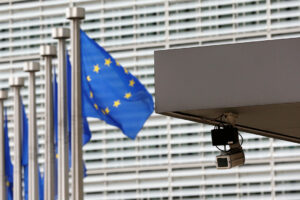




Quarterly Economic Growth Release: More BSP cuts to come
 DOWNLOAD
DOWNLOAD

Monthly Economic Update: Fed catches up
 DOWNLOAD
DOWNLOAD

Inflation Update: Steady and mellow
 DOWNLOAD
DOWNLOAD


Philippines-EU free trade deal seen in 5 years

The Department of Trade and Industry (DTI) aims to finish the formal negotiations for the free trade agreement (FTA) between the Philippines and the European Union (EU) within five years.
“We will really exert all efforts possible to get it (FTA negotiations) done before the end of the Marcos administration. We have five years. It can be done,” Trade Secretary Alfredo E. Pascual said during a media briefing in Makati City on Tuesday.
“We already had the negotiations before. There is momentum. Both sides want it,” he added.
On Monday, President Ferdinand R. Marcos, Jr. and European Commission President Ursula von der Leyen announced both sides are exploring the resumption of negotiations for an FTA.
The EU and the Philippines first launched negotiations for an FTA in 2015, but these have been stalled since 2017. Negotiations were put on hold due to issues on intellectual property rights and data exclusivity, among others.
Mr. Pascual said the EU and the Philippines are expected to begin the bilateral “scoping process” for the FTA in early September.
“In the coming months, government technical experts from the Philippines and the EU will engage in comprehensive discussions covering various topics, including market access for goods and services, investment liberalization, trade and sustainable development, government procurement, dispute settlement, etc.,” he added.
Trade Undersecretary Ceferino S. Rodolfo said he expects three major scoping discussions to be done before formal negotiations begin by 2024.
“Hopefully by the end of the year, the chief negotiators will already have their overall assessment of the scoping paper, if both sides are already happy, and then from there, proceed with the actual FTA negotiations,” Mr. Rodolfo said.
Sectors to benefit
Mr. Rodolfo said some of the sectors that could benefit from the EU-Philippines FTA include garments and wearables, agriculture, minerals, digital trade, and energy. The FTA negotiations will also include discussions on sustainable development, he added.
“The average tariff for wearables is about 12%. It is quite high,” Mr. Rodolfo said.
“That is why under an FTA with a more liberalized rules of origin, some of the sectors that will have a surge is the garments and wearables and agriculture. If you look at the tariff profile of most advanced economies, the highly protected sectors will be the resource-based, in particular like the agriculture and the garments,” he added.
Maritess Jocson-Agoncillo, Confederation of Wearable Exporters of the Philippines (CONWEP) executive director, told reporters the EU-Philippines FTA could create between 120,000 and 250,000 new jobs in the sector within the first two years of its implementation.
Ms. Jocson-Agoncillo said the garments industry would also boost its export value to the EU, which has been hampered by the high tariffs.
“We’re seeing about $600 million worth of exports for the first two to three years of the negotiation and then it can go push the $800 million to $1-billion export value on the first two years of (the FTA’s) actual implementation,” Ms. Jocson-Agoncillo said.
“We will benefit with the FTA because we have market access issues. I hope the Philippine government can really speed up the negotiations so that we can start improving our performance to the European market,” she added.
Ms. Jocson-Agoncillo also said that the FTA could entice the entry of textile mill investments to the Philippines, which would provide the raw materials used by the industry.
At present, the industry sources raw materials from Taiwan, South Korea, and China.
“We need new textile mills so that the industry does not become import dependent,” Ms. Jocson-Agoncillo said. “Once the FTA is in place, the European buyers of apparel shoes and bags will definitely be looking our way.”
Information Technology and Business Process Association of the Philippines President Jack Madrid said the FTA could also expand the market share of the Philippines’ information technology and business process management sector in the EU.
“The FTA will open up further our potential market share to increase Europe’s contribution which at present is well below 10% (of the overall),” Mr. Madrid said.
In 2022, bilateral trade between the EU and the Philippines was valued at €18.38 billion. — Revin Mikhael D. Ochave
This article originally appeared on bworldonline.com





 By BusinessWorld
By BusinessWorld